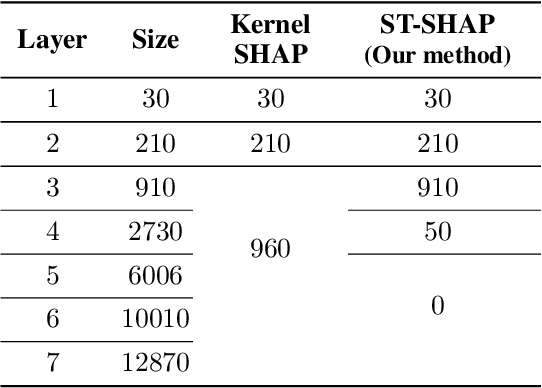Maurice Tchuente
Shaping Up SHAP: Enhancing Stability through Layer-Wise Neighbor Selection
Dec 19, 2023



Abstract:Machine learning techniques, such as deep learning and ensemble methods, are widely used in various domains due to their ability to handle complex real-world tasks. However, their black-box nature has raised multiple concerns about the fairness, trustworthiness, and transparency of computer-assisted decision-making. This has led to the emergence of local post-hoc explainability methods, which offer explanations for individual decisions made by black-box algorithms. Among these methods, Kernel SHAP is widely used due to its model-agnostic nature and its well-founded theoretical framework. Despite these strengths, Kernel SHAP suffers from high instability: different executions of the method with the same inputs can lead to significantly different explanations, which diminishes the utility of post-hoc explainability. The contribution of this paper is two-fold. On the one hand, we show that Kernel SHAP's instability is caused by its stochastic neighbor selection procedure, which we adapt to achieve full stability without compromising explanation fidelity. On the other hand, we show that by restricting the neighbors generation to perturbations of size 1 -- which we call the coalitions of Layer 1 -- we obtain a novel feature-attribution method that is fully stable, efficient to compute, and still meaningful.
A general graph-based framework for top-N recommendation using content, temporal and trust information
May 06, 2019



Abstract:Recommending appropriate items to users is crucial in many e-commerce platforms that contain implicit data as users' browsing, purchasing and streaming history. One common approach consists in selecting the N most relevant items to each user, for a given N, which is called top-N recommendation. To do so, recommender systems rely on various kinds of information, like item and user features, past interest of users for items, browsing history and trust between users. However, they often use only one or two such pieces of information, which limits their performance. In this paper, we design and implement GraFC2T2, a general graph-based framework to easily combine and compare various kinds of side information for top-N recommendation. It encodes content-based features, temporal and trust information into a complex graph, and uses personalized PageRank on this graph to perform recommendation. We conduct experiments on Epinions and Ciao datasets, and compare obtained performances using F1-score, Hit ratio and MAP evaluation metrics, to systems based on matrix factorization and deep learning. This shows that our framework is convenient for such explorations, and that combining different kinds of information indeed improves recommendation in general.
Link Stream Graph for Temporal Recommendations
Mar 27, 2019



Abstract:Several researches on recommender systems are based on explicit rating data, but in many real world e-commerce platforms, ratings are not always available, and in those situations, recommender systems have to deal with implicit data such as users' purchase history, browsing history and streaming history. In this context, classical bipartite user-item graphs (BIP) are widely used to compute top-N recommendations. However, these graphs have some limitations, particularly in terms of taking temporal dynamic into account. This is not good because users' preference change over time. To overcome this limit, the Session-based Temporal Graph (STG) was proposed by Xiang et al. to combine long- and short-term preferences in a graph-based recommender system. But in the STG, time is divided into slices and therefore considered discontinuously. This approach loses details of the real temporal dynamics of user actions. To address this challenge, we propose the Link Stream Graph (LSG) which is an extension of link stream representation proposed by Latapy et al. and which allows to model interactions between users and items by considering time continuously. Experiments conducted on four real world implicit datasets for temporal recommendation, with 3 evaluation metrics, show that LSG is the best in 9 out of 12 cases compared to BIP and STG which are the most used state-of-the-art recommender graphs.
Réseaux d'Automates de Caianiello Revisité
Feb 10, 2006



Abstract:We exhibit a family of neural networks of McCulloch and Pitts of size $2nk+2$ which can be simulated by a neural networks of Caianiello of size $2n+2$ and memory length $k$. This simulation allows us to find again one of the result of the following article: [Cycles exponentiels des r\'{e}seaux de Caianiello et compteurs en arithm\'{e}tique redondante, Technique et Science Informatiques Vol. 19, pages 985-1008] on the existence of neural networks of Caianiello of size $2n+2$ and memory length $k$ which describes a cycle of length $k \times 2^{nk}$.
 Add to Chrome
Add to Chrome Add to Firefox
Add to Firefox Add to Edge
Add to Edge